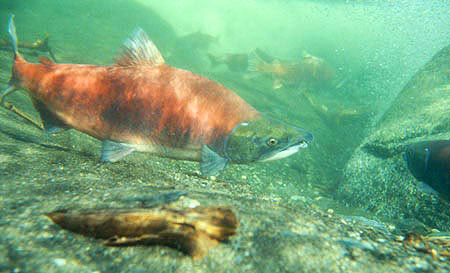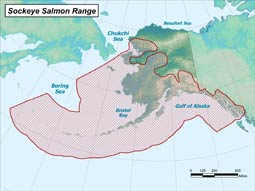Sockeye Salmon
(Oncorhynchus nerka)
Species Profile
Did You Know?
Landlocked sockeye salmon rarely grow to more than 14 inched in length and are called “kokanee”.
General Description
Sockeye salmon are one of the smaller species of Pacific salmon, measuring 18 to 31inches in length and weighing 4-15 pounds. Sea-going sockeye salmon have iridescent silver flanks, a white belly, and a metallic green-blue top, giving them their "blueback" name. Some fine black speckling may occur on the back, but large spots are absent. Sockeye salmon are prized for their firm, bright-orange flesh.
As sockeye salmon return upriver to their spawning grounds, their bodies turn brilliant red and their heads take on a greenish color, hence their other common name, “red” salmon. Breeding-age males develop a humped back and hooked jaws filled with tiny, visible teeth. Juveniles, while in fresh water, have dark, oval parr marks on their sides. These parr marks are short-less than the diameter of the eye-and rarely extend below the lateral line.
Life History
Like all species of Pacific salmon, sockeye salmon are anadromous, living in the ocean but entering fresh water to spawn. Sockeye salmon spend one to four years in fresh water and one to three years in the ocean.
In Alaska, most sockeye salmon return to spawn in June and July in freshwater drainages that contain one or more lakes. Spawning itself usually occurs in rivers, streams, and upwelling areas along lake beaches. During this time 2,000 – 5,000 eggs are deposited in one or more “redds”, which the female digs with her tail over several days time. Males and females both die within a few weeks after spawning.
Eggs hatch during the winter, and the young “alevins” remain in the gravel, living off their yolk sacs. In the spring. they emerge from the gravel as “fry” and move to rearing areas. In systems with lakes, juveniles usually spend one to three years in fresh water, feeding on zooplankton and small crustaceans, before migrating to the ocean in the spring as “smolts”. However, in systems without lakes, many juveniles migrate to the ocean soon after emerging from the gravel.
Smolts weigh only a few ounces upon entering salt water, but they grow quickly during their 1-3 years in the ocean, feeding on plankton, insects, small crustaceans, and occasionally squid and small fish. Alaska sockeye salmon travel thousands of miles during this time, drifting in the counter-clockwise current of the Alaska Gyre in the Gulf of Alaska. Eventually they return to spawn in the same freshwater system where they were hatched.
Range and Habitat
Fresh water lakes, streams and estuaries provide important habitat for spawning and rearing sockeye salmon. On the west coast of North America, sockeye salmon range from the Klamath River in Oregon to Point Hope in northwestern Alaska.
The largest sockeye salmon populations are in the Kvichak, Naknek, Ugashik, Egegik, and Nushagak Rivers that flow into Alaska’s Bristol Bay, plus the Fraser River system in Canada. In good years, these runs can number in the tens of millions of fish.
Status, Trends, and Threats
Pacific salmon species on the west coast of the lower 48 United States have experienced dramatic declines in abundance during the past several decades as a result of several factors, including water diversions for agriculture and flood control; loss of habitat due to hydropower, resource extraction and development; and direct mortality from entrainment by hydropower projects. As a result, two lower-48 populations of sockeye salmon have been listed under the Endangered Species Act.
For the time being, salmon habitat in Alaska remains mostly pristine. There are hundreds of stocks of sockeye salmon throughout the state of Alaska and their population trends are diverse: Some stocks are in decline while others are at equilibrium or increasing. Potential future threats include habitat loss, habitat degradation, climate change, and over fishing.
Fast Facts
-
Size
Length = 24 inches (Record: 31 inches); Weight = 6 lbs (Record: 16 lbs). -
Lifespan
3 to 7 years -
Distribution/Range
North America "– Klamath River, OR to the Chukchi Sea. Asia – Hokkaido, Japan to Anadyr River, Siberia -
Diet
Zooplankton,small crustaceans, small fish -
Predators
Marine mammals, bears -
Remarks
The most economically important species of salmon in Alaska -
Other Names
Red and blueback salmon, kokanee (landlocked form in lower 48 states and Canada) -
Stock Status
3rd most abundant species of Pacific salmon. Populations currently healthy in Alaska. Human induced habitat loss and direct mortality has depressed populations in the lower 48 states.


